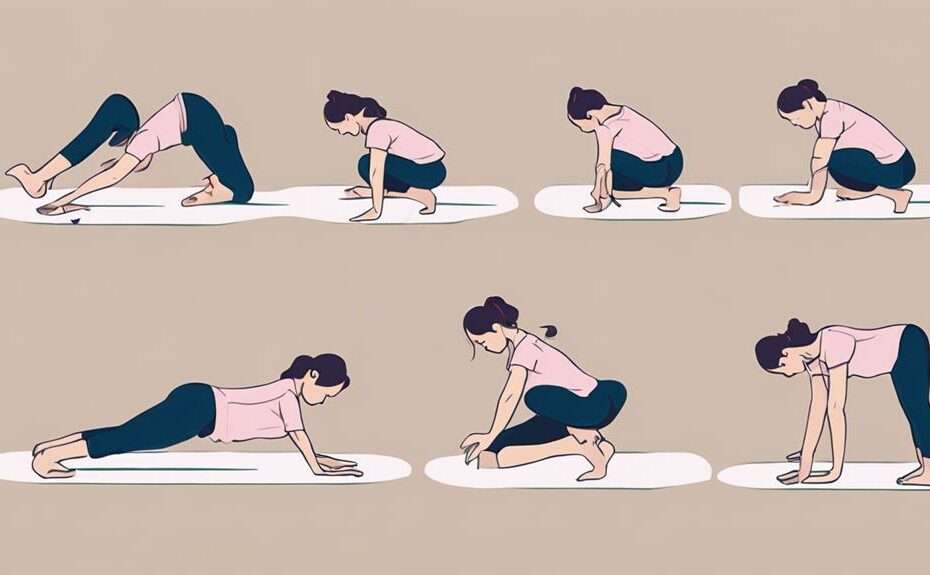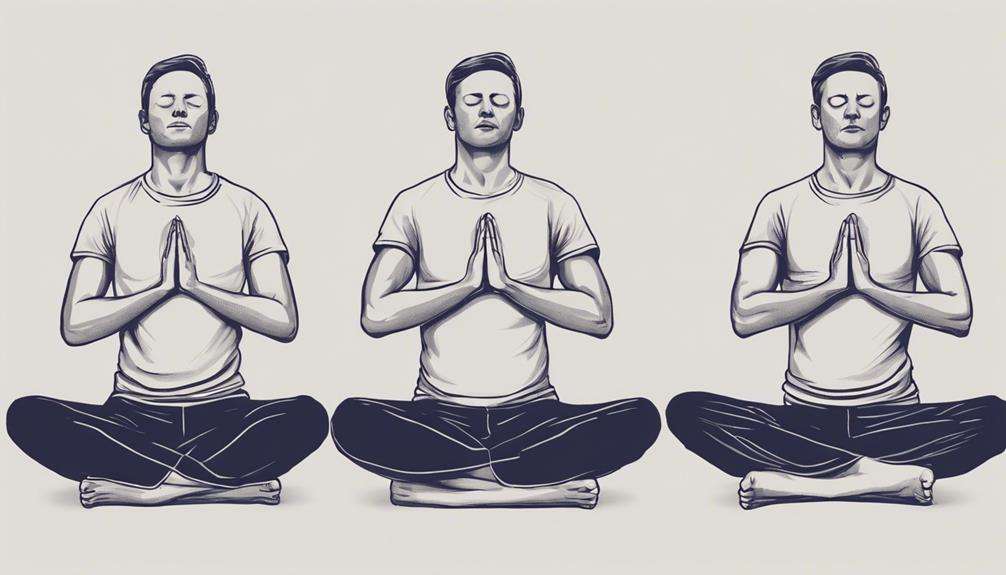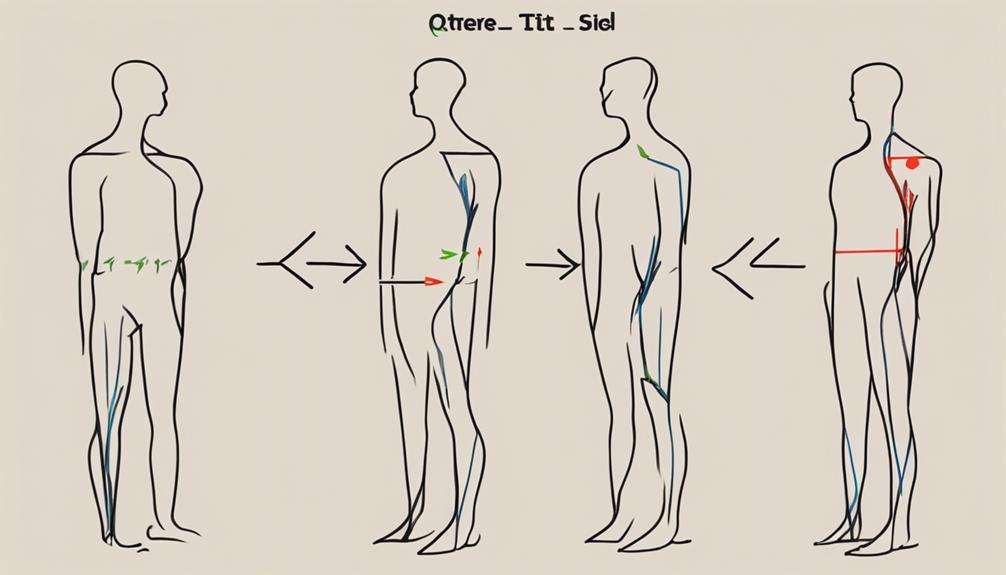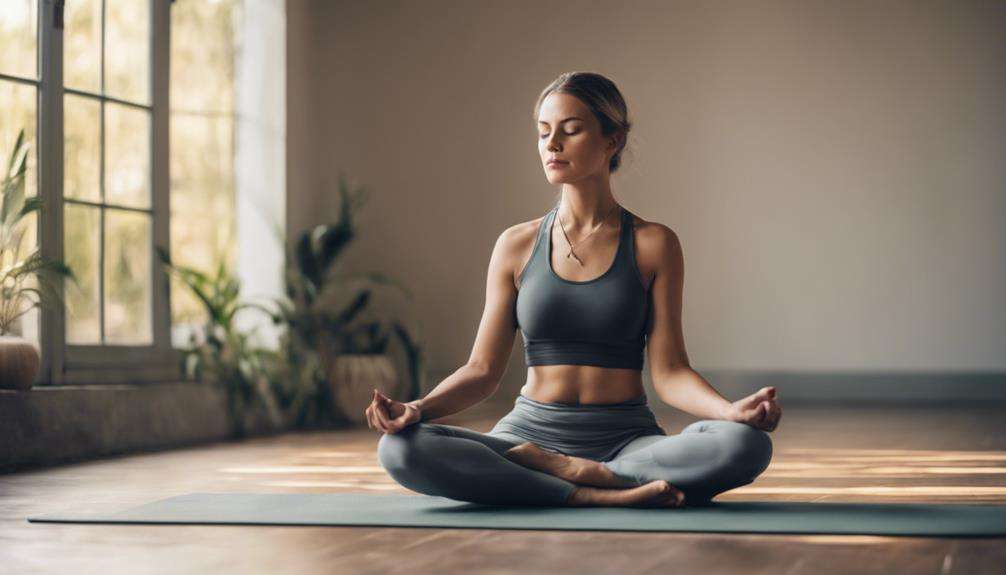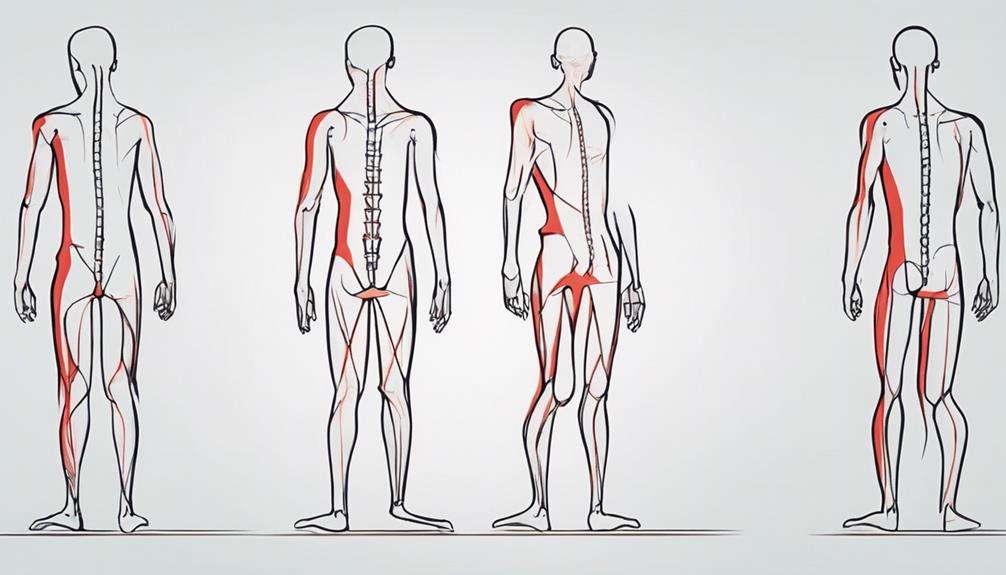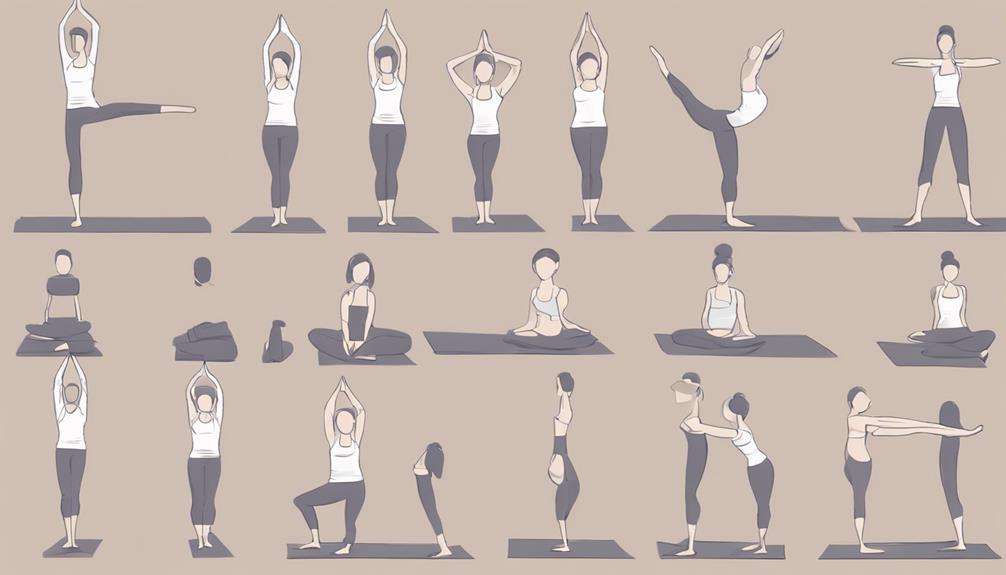Feeling the tension in your spine after a long day of sitting at your desk?
You might find relief in a few simple stretches that can make a world of difference in your posture and overall well-being.
By incorporating targeted movements into your daily routine, you can help realign your spine and improve your body's alignment.
But what are these stretches, and how can they benefit you in the long run?
Let's explore these effective spine realignment techniques that could transform how you feel and move throughout your day.
Key Takeaways
- Spine realignment stretches target thoracic and lumbar spine for enhanced posture.
- Muscle tension release and spinal alignment improvement through targeted stretches.
- Core strengthening aids in spinal stability and posture enhancement.
- Regular practice promotes stress relief, mental calmness, and overall wellness.
Spinal Twist for Torso Mobility
To enhance your torso mobility and promote spinal flexibility, incorporate the spinal twist stretch into your daily routine for improved posture wellness.
Spinal twists are effective in targeting the thoracic and lumbar spine, helping to release tension in the muscles surrounding your spine. By engaging in this stretch regularly, you can reduce stiffness, enhance spinal alignment, and boost posture by expanding the range of motion in your torso.
The twisting motion involved in the spinal twist stretch not only aids in stretching and massaging the muscles but also assists in stimulating the internal organs, which can contribute to better digestion and detoxification processes. Furthermore, incorporating spinal twists into your routine can play a significant role in alleviating back pain and enhancing overall spinal health.
Cat-Cow Pose for Spine Flexibility
Enhance your spine flexibility and promote overall spinal health with the dynamic yoga stretch known as the Cat-Cow Pose. This exercise involves moving between arching your back (cow) and rounding your back (cat), creating a gentle flow that stretches and strengthens the spine. By practicing Cat-Cow regularly, you can increase spine flexibility and mobility while reducing stiffness.
Cat-Cow Pose isn't only beneficial for the physical aspects of spine health but also aids in alleviating back pain and improving posture. The movement engages the core muscles, promoting stability and balance throughout the body. As you flow through the poses, focus on synchronizing your breath with each movement to enhance the benefits further. This yoga stretch helps enhance your range of motion, making daily activities easier and more comfortable.
Incorporating Cat-Cow Pose into your routine can contribute to a healthier spine, greater flexibility, and improved overall well-being.
Downward-Facing Dog for Full Body Stretch
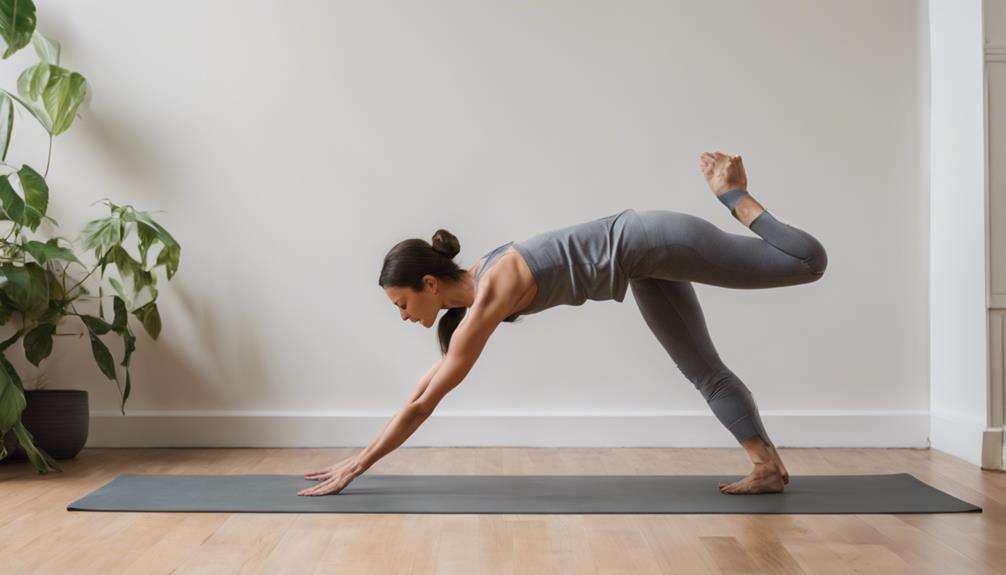
When practicing Downward-Facing Dog, remember to engage your core muscles to support your lower back and keep your spine lengthened.
This pose also stretches your shoulders and hamstrings, promoting overall flexibility and posture improvement.
Benefits of Downward Dog
For a thorough full body stretch targeting various muscle groups and promoting spine realignment, consider incorporating Downward Dog into your regular exercise routine.
Downward Dog is a versatile pose that stretches the spine, shoulders, hamstrings, and calves, helping to lengthen the spine and relieve tension for better posture. By engaging your arms, shoulders, and core muscles, this pose enhances stability and supports spinal alignment.
Additionally, practicing Downward Dog regularly can increase flexibility, range of motion, and overall alignment, contributing to excellent spine realignment and posture wellness. The pose also improves circulation, reduces stress, and promotes a sense of calm, benefiting both your physical and mental well-being.
Proper Form Tips
To achieve perfect spine alignment in Downward-Facing Dog for a full body stretch, make sure a straight line from your hands to hips to heels is maintained. Engage your core muscles to support the lower back, preventing overarching.
Keep your shoulder blades broad, away from your ears, and focus on a neutral spine alignment to alleviate tension in the upper back. Ground firmly through your palms and heels, lengthening the spine to create space between vertebrae.
Breathe deeply, allowing yourself to relax into the stretch for maximum benefits. By following these proper form tips, you'll enhance the effectiveness of Downward-Facing Dog and promote overall posture wellness.
Cobra Pose for Lower Back Strength
Strengthen your lower back muscles and improve spine flexibility with the invigorating Cobra Pose, also known as Bhujangasana. This yoga posture targets the lower back muscles, enhancing their strength and endurance.
By practicing Cobra pose regularly, you can promote spine flexibility and alleviate lower back pain. Additionally, this pose helps in improving posture by opening up the chest and shoulders, counteracting the effects of slouching or hunching forward.
Engaging in Cobra pose also aids in aligning the spine correctly, reducing stiffness, and enhancing overall core engagement. The stretching of the front body in Cobra pose contributes to realigning the spine and releasing any tension built up in the lower back.
Incorporating this pose into your routine can be beneficial for maintaining a healthy posture, especially if you spend prolonged periods sitting during the day.
Child's Pose for Spine Decompression
Begin your spine decompression journey with the restorative yoga posture known as Child's Pose. This gentle stretch is excellent for elongating the back muscles, promoting spinal alignment, and relieving tension in the lower back. Child's Pose also provides a thorough stretch to the hips and thighs, making it an all-encompassing posture for overall body relaxation.
By incorporating Child's Pose into your daily routine, you can improve your posture greatly. This stretch helps release tension in the spine, shoulders, and neck, fostering relaxation and realignment throughout your body. Holding Child's Pose for a few breaths each day can effectively decompress and lengthen your spine, supporting overall spine health, flexibility, and posture improvement.
Whether you're a beginner or an experienced yogi, Child's Pose is a beginner-friendly stretch that offers numerous benefits for your body. Embrace this posture to experience the soothing effects it has on your lower back, hips, and overall posture.
Bridge Pose for Core Activation
When practicing Bridge Pose, focus on engaging your core muscles to enhance stability and spinal support.
Ensuring proper form is essential to maximize the benefits of this pose for your core strength.
Beginners can explore variations to gradually build up their core activation and improve posture wellness.
Core Strength Benefits
To enhance your core strength effectively and promote better posture, consider incorporating the Bridge Pose into your routine.
Bridge Pose is a valuable stretch that targets the deep core muscles, including the transverse abdominis and pelvic floor, while also engaging the lower back and glutes. By regularly practicing Bridge Pose, you can strengthen these muscles, improving overall stability and support for your spine.
This increased core strength can help prevent and alleviate lower back pain, contributing to better posture and alignment. The versatility of Bridge Pose allows for modifications based on individual fitness levels and requirements, making it accessible for anyone seeking to enhance their core strength for improved posture and overall wellness.
Proper Form Guidelines
For best core activation in Bridge Pose, make sure that you lie on your back with knees bent, feet hip-width apart, and arms positioned by your sides. As you lift your hips off the ground, focus on pressing into your feet and engaging your core to form a straight line from shoulders to knees.
This proper form not only targets the core muscles but also strengthens the posterior chain, which includes the muscles supporting the spine. By incorporating Bridge Pose into your routine, you can enhance spinal mobility, alleviate back pain, and improve overall posture alignment.
Consistent practice of this pose won't only benefit your core strength but also contribute to your overall posture wellness.
Variations for Beginners
Building upon the foundation of proper form in Bridge Pose, beginners can explore variations that cater to individual needs while still focusing on core activation for spine realignment.
In this pose, the activation of core muscles, including the lower back, glutes, and hamstrings, is essential for improving spinal stability and posture. By lifting the hips off the ground, you engage these muscles effectively.
To enhance the core activation further, you can try holding the Bridge Pose for longer durations or incorporating gentle pulses up and down. These variations won't only strengthen your core but also contribute to better posture and overall spinal wellness.
Remember to maintain proper alignment and listen to your body's limits as you explore these beginner-friendly Bridge Pose variations.
Standing Forward Bend for Hamstring Release
A beneficial stretch for releasing tension in the hamstrings, calves, and hips while improving spine flexibility is the Standing Forward Bend yoga pose.
This pose not only targets the hamstrings for increased flexibility but also helps alleviate stress on the lower back, promoting better spine alignment. By engaging your core muscles during this stretch, you enhance the benefits for both your hamstrings and your overall posture.
The Standing Forward Bend is particularly effective for hamstring release, as it allows for a deep stretch along the back of your legs, aiding in lengthening tight muscles. This pose encourages blood flow to the brain, promoting stress relief and mental calmness.
Regular practice of the Standing Forward Bend can contribute significantly to improving your posture by elongating the spine and opening up the chest. Remember to maintain proper alignment and engage your core to maximize the advantages of this posture-enhancing stretch.
Frequently Asked Questions
Can Stretching Realign Your Spine?
Stretching can indeed realign your spine by enhancing flexibility and promoting proper alignment techniques. Consistent stretching routines benefit posture, spinal health, and overall body alignment. Incorporating these practices into your daily routine can lead to significant improvements.
How Can I Straighten My Spine and Improve My Posture?
To straighten your spine and improve posture, focus on spine alignment with targeted exercises. Strengthen core muscles, practice balance techniques, and include flexibility training. Maintain spinal health by incorporating alignment tips into your routine for better posture.
How Can I Realign My Spine Naturally?
To realign your spine naturally, consider incorporating yoga poses, chiropractic adjustments, Pilates exercises, massage therapy, core strengthening, physical therapy, and corrective exercises into your routine. These methods can help improve posture, relieve pain, and enhance spinal alignment.
Can You Correct Years of Bad Posture?
You can correct years of bad posture by improving your posture habits, prioritizing spinal health, doing neck exercises, building core strength, adjusting desk ergonomics, relieving back pain, and addressing pelvic tilt through consistent practice and dedication to posture improvement exercises.
Conclusion
Incorporate these effective spine realignment stretches into your daily routine to improve posture and overall wellness. Remember, 'a straight spine is a reflection of a balanced life.'
Consistency is key in achieving lasting results, so make sure to practice these stretches regularly. Take care of your spine, and it will take care of you.
Keep stretching, keep aligning, and feel the benefits of a healthier, more aligned posture.
